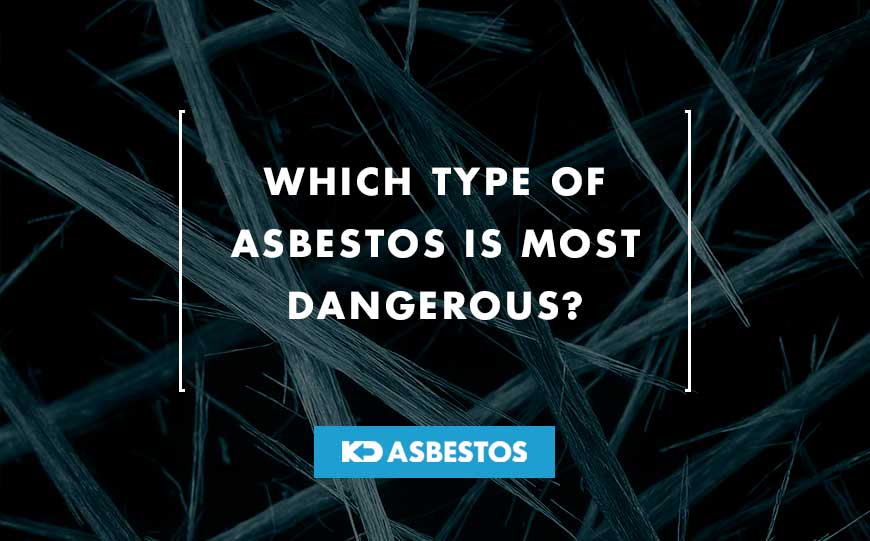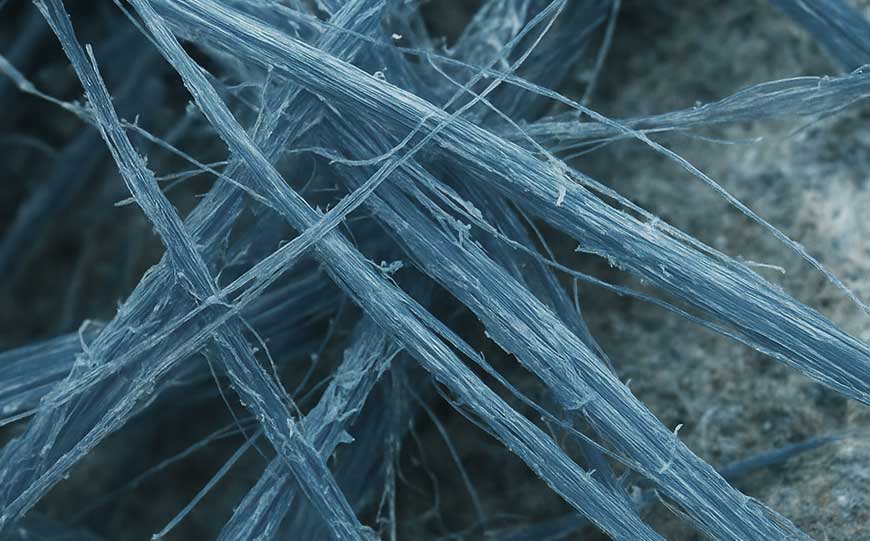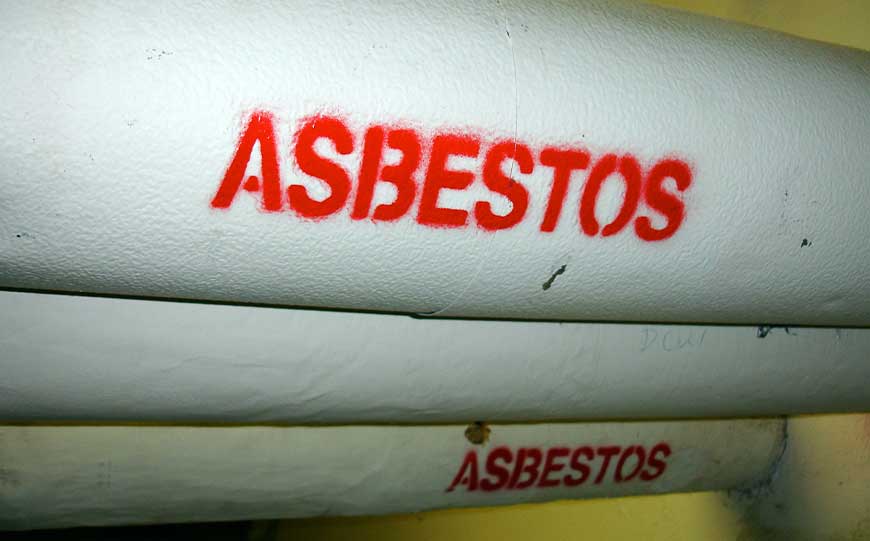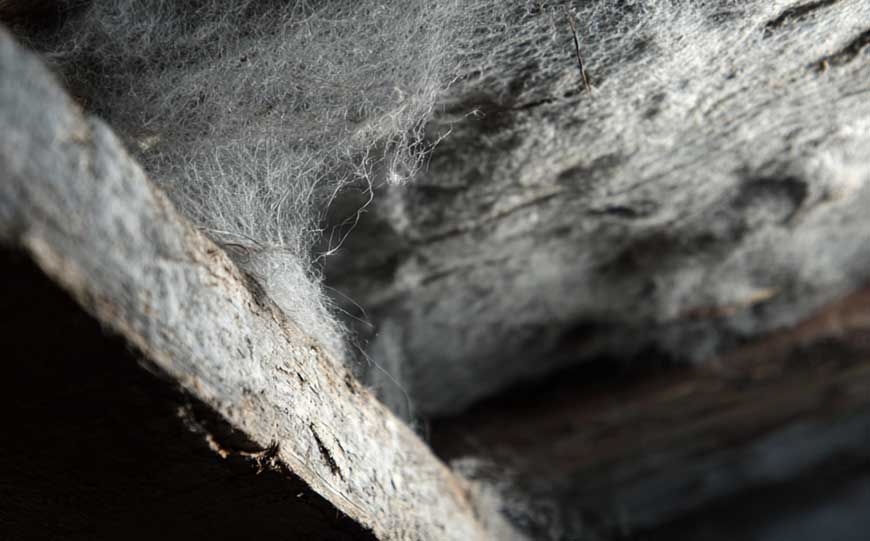
Asbestos is a general name for several naturally occurring minerals that form long, thin fibres.
These fibrous minerals were once added to many building materials because they are very strong and fire-resistant.
For much of the 20th century, asbestos was used in insulation, roofing, cement, floor tiles and other products.
Unfortunately, it was later discovered that inhaling asbestos dust can cause serious illnesses.
Tiny asbestos fibres can become lodged in the lungs and lead to many debilitating and fatal diseases.
Due to these health risks, all use of asbestos has been banned in the UK since 1999.
Table of Contents
Types of Asbestos
There are six main types of asbestos, which are commonly grouped into two families: serpentine and amphibole.
Chrysotile
Chrysotile (white asbestos) is the only serpentine type and was the most widely used form in buildings.
Chrysotile fibres are soft, flexible and curly.
It was used in many products such as cement sheets, roofing felt, brake pads, and pipe insulation.
Chrysotile is still dangerous and is a known carcinogen, though it is considered less potent than the amphibole types.
Amosite
Amosite (brown asbestos) has straight, brittle fibres with a brown colouration.
It was commonly used in construction materials like insulation boards, ceiling tiles, and cement sheets.
Brown asbestos is highly hazardous if disturbed.
Crocidolite
Crocidolite (blue asbestos) has very thin, sharp blue fibres and is widely regarded as the most dangerous form of asbestos.
Its fibres are easily inhaled and can lodge deep in the lungs.
Blue asbestos was often used in high-temperature insulation, such as steam engines, pipes and boilers.
It was also used in some spray-on fireproof coatings.
It is extremely friable (easily crumbled) and releases fibres readily, contributing to its high health risk.
Tremolite, Actinolite, and Anthophyllite
These are less common types of asbestos.
They were not often used commercially, but can appear as contaminants in other minerals like talc and vermiculite.
Like all asbestos forms, they have fibrous structures and can cause lung damage and cancer if disturbed.
These types are rare to encounter, but any exposure to their fibres can still be dangerous.
Which Type of Asbestos is Most Dangerous?

Crocidolite, or blue asbestos, is often cited as the most deadly form of asbestos due to its needle-like fibres.
All types of asbestos can harm health, but crocidolite is generally considered the most dangerous.
Its sharp, delicate fibres penetrate lung tissue more easily than other types.
This leads to a higher risk of mesothelioma and other cancers.
Blue and brown asbestos (the amphibole varieties) are recognised as more hazardous than white asbestos.
Among these, crocidolite is regarded as the most lethal.
It was used less than white asbestos, but its fibres are more aggressive in the lungs.
Crocidolite has been linked to more cases of mesothelioma than other forms, even with lower levels of exposure.
Because of its danger, blue asbestos was one of the first types to be banned.
What are the Issues with the Most Dangerous Type of Asbestos?

The main issue with crocidolite (blue asbestos) is the severe health impact of its fibres when inhaled.
All asbestos fibres can cause disease, but crocidolite’s fibres tend to stay in the lungs for a long time and do great damage.
Asbestosis
Once breathed in, the tiny sharp fibres irritate and scar lung tissue.
Over years, this can develop into asbestosis (permanent lung scarring) or cause cellular changes leading to cancer.
Mesothelioma
Blue asbestos is particularly notorious for causing mesothelioma, a cancer of the lung’s lining that is almost exclusively linked to asbestos exposure.
Mesothelioma is an extremely aggressive and fatal disease.
Most patients survive only a short time after diagnosis.
Crocidolite exposure is thought to produce mesothelioma at a higher rate than exposure to white asbestos, even when the exposure is relatively low.
Other Cancers
In addition to mesothelioma, inhaling blue asbestos fibres can also lead to lung cancer and other respiratory conditions.
There is often a long latency period (10–40 years) between the exposure and the onset of illness, so people may not realise they were harmed until decades later.
The fibres are so hazardous that there is no safe level of exposure.
Even a brief or one-time inhalation of blue asbestos dust could potentially trigger disease years down the line.
For these reasons, crocidolite is considered the most dangerous type of asbestos, and any amount of it in a building is a serious concern.
Where is the Most Dangerous Type of Asbestos Found?

Crocidolite can still be found in some older buildings and products from decades past.
Before its dangers were known, crocidolite was used for its superior heat and chemical resistance.
Insulation
In the UK, blue asbestos was commonly used in the 1950s and 1960s as insulation on steam engines, pipes and boilers.
It was also blended into certain spray-applied fireproofing and insulation coatings.
Some cement products and ceiling or floor tiles in that era contained crocidolite, although chrysotile was more often used in cement.
Shipbuilding and Industrial
Blue asbestos was especially valued in shipbuilding and industrial settings because it resists saltwater corrosion.
For example, naval ships and power stations sometimes had crocidolite insulation.
Pipe Lagging
If you have an older home (built before the 1980s), the most likely places to find blue asbestos would be in pipe lagging (the wrapping around old pipes), boiler insulation, or sprayed insulation in attics or structural beams.
In Britain, the import and use of crocidolite was banned in 1985, so any building constructed after that should not contain it.
However, many earlier structures still contain hidden blue asbestos in their fabric.
It is often a blue-grey fluffy or fibrous material when visible, sometimes mixed with other materials.
Because of the high risk, any suspected blue asbestos in an old building should be left undisturbed and dealt with by professionals.
What to do if you Find the Most Dangerous Type of Asbestos
If you suspect that you have found blue asbestos (or any asbestos) in your home, you must be extremely careful.
Do not disturb or attempt to remove the material yourself as disturbing it could release a cloud of deadly fibres.
The best immediate action is to stop any work in that area and keep people away from it.
Avoid touching the suspected asbestos and do not sweep or vacuum the debris as this would spread fibres into the air.
The next step is to get professional help.
In the UK, you should contact an environmental health officer at your local council for advice if you discover asbestos at home.
They can guide you on what to do and help you find a licensed asbestos removal contractor, such as us here at KD Asbestos.
A professional asbestos surveyor can take a sample and have it tested to confirm what type of asbestos is present.
If it does turn out to be asbestos, especially crocidolite or amosite, it will likely need to be removed or sealed by specialists under strict safety procedures.
UK regulations require that high-risk asbestos materials be handled by licensed contractors.
Until help arrives, it is safest to leave the material alone.
Do not drill, cut, or try to bag it yourself.
Always prioritise your safety and assume any suspected asbestos is dangerous until proven otherwise.
What Type of Asbestos Product is the Most Dangerous?

When assessing risk, it is not only the type of asbestos mineral that matters, but also the form of the product containing it.
The most dangerous asbestos products are those that are friable, meaning they easily crumble or break apart.
Friable materials release asbestos fibres readily into the air, making asbestos exposure more likely.
By contrast, non-friable (or ‘bonded’) asbestos products have the fibres tightly bound in a solid matrix (like cement or resin).
This keeps them from escaping unless the material is severely damaged.
For homeowners, this means that loose, fluffy asbestos insulation is far more hazardous than an intact asbestos cement roof panel.
Sprayed asbestos coatings and pipe lagging are also very high-risk products, since they often contain amphibole asbestos and are highly friable.
If these materials are disturbed or deteriorating, fibres can be released in large quantities.
On the other hand, asbestos cement sheets, vinyl floor tiles, or textured coatings (like Artex) contain asbestos that is bound in a hard material.
This means they tend to release fibres more slowly – these are relatively less dangerous unless they are cut, broken or sanded.
It’s important to remember that all asbestos products are potentially dangerous, but friable materials pose the greatest immediate risk.
Any product that can easily produce dust (especially products made largely of asbestos with minimal binding material) should be treated with extreme caution.
Always consult professionals to assess the risk of any asbestos-containing material in your home.
Key Takeaways
You should now have more of an understanding of which type of asbestos is the most dangerous.
All forms of asbestos are hazardous to human health, but blue asbestos (crocidolite) is often singled out as the most dangerous type.
Its fine, sharp fibres make it especially likely to cause deadly illnesses like mesothelioma.
Brown asbestos (amosite) is nearly as dangerous, and even white asbestos (chrysotile) can still be lethal and must be treated with caution.
The level of risk also depends on the condition of the asbestos-containing material.
The cost of professional inspection and removal is well worth avoiding exposure to this carcinogenic material.
Remember that asbestos-related diseases take decades to appear, and prevention of exposure is the only real protection.
By knowing the types of asbestos and which are most dangerous, homeowners can make informed decisions to keep themselves and their families safe.
For more information on the most dangerous type of asbestos, or help with any of your asbestos needs, get in contact with us here at KD Asbestos.